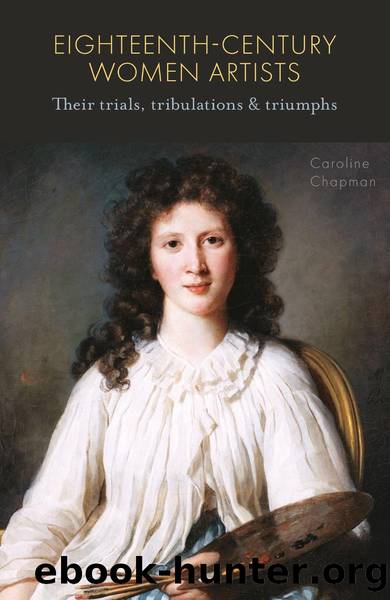Eighteenth-Century Women Artists by Caroline Chapman

Author:Caroline Chapman [Caroline Chapman]
Language: eng
Format: epub
ISBN: 9781910787502
Publisher: Unicorn Publishing Group
Published: 2017-03-14T16:00:00+00:00
Bachaumont, however, qualifies his praise by pointing out that her celebrity was aided by her youth, appearance, powerful contacts and elegant entertainments.28
The greatest advantage of membership of the Académie was that it enabled artists to exhibit in the annual Salons, the supreme marketplace. The majority of women artists, however, had to rely on alternative institutions to display their work, such as the Salon de la Correspondance in Paris and other exhibiting societies which grew up to cater for the growing number of artists and spectators. (Membership of the Académie Royale did not, however, allow women to compete for the coveted Prix de Rome.)
In 1791 fresh attempts were made to persuade the Académie Royale to admit more than four women members. The response from Louis XVIâs imperious arts minister, Comte dâAngiviller, was unequivocal: âthis number is adequate to honour talent: women can never be useful to the progress of the arts since the modesty of their sex prevents them from studying nude figures in the school established by Your Majesty.â29 Since being unable to draw from life had nothing to do with womenâs modesty but everything to do with the Académie forbidding women to attend its schools, this was a wonderfully Catch-22 answer.
If the Académie Royaleâs attitude to women artists appeared unjust, admitting four women was double that of Londonâs Royal Academy, which had elected Angelica Kauffman and Mary Moser as founder members in 1768 but declined to elect another (Dame Laura Knight) until 1936, 168 years later.
31. Adélaïde Labille-Guiard, Augustin Pajou, 1782
This painting, submitted by the artist as her reception piece for the Académie Royale is, in effect, a double portrait as it shows not only the sculptor Pajou but his teacher Jean-Baptiste Lemoyne. Both Labille-Guiard and Vigée Le Brun were accepted for membership on the same day, encouraging the perception that they were rivals.
Download
This site does not store any files on its server. We only index and link to content provided by other sites. Please contact the content providers to delete copyright contents if any and email us, we'll remove relevant links or contents immediately.
Kathy Andrews Collection by Kathy Andrews(11342)
The remains of the day by Kazuo Ishiguro(8415)
Paper Towns by Green John(4811)
Spare by Prince Harry The Duke of Sussex(4804)
Industrial Automation from Scratch: A hands-on guide to using sensors, actuators, PLCs, HMIs, and SCADA to automate industrial processes by Olushola Akande(4630)
The Body: A Guide for Occupants by Bill Bryson(4595)
Machine Learning at Scale with H2O by Gregory Keys | David Whiting(3660)
Be in a Treehouse by Pete Nelson(3654)
Harry Potter and the Goblet Of Fire by J.K. Rowling(3619)
Never by Ken Follett(3549)
Goodbye Paradise(3460)
The Remains of the Day by Kazuo Ishiguro(3148)
Into Thin Air by Jon Krakauer(3135)
The Cellar by Natasha Preston(3079)
The Genius of Japanese Carpentry by Azby Brown(3044)
Fairy Tale by Stephen King(2971)
120 Days of Sodom by Marquis de Sade(2947)
Drawing Shortcuts: Developing Quick Drawing Skills Using Today's Technology by Leggitt Jim(2943)
The Man Who Died Twice by Richard Osman(2823)
